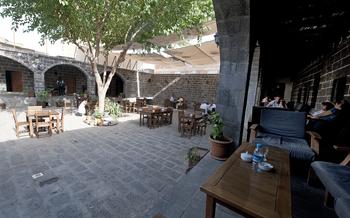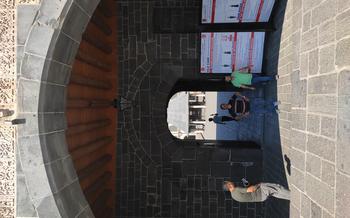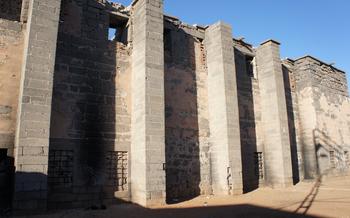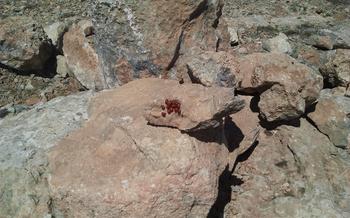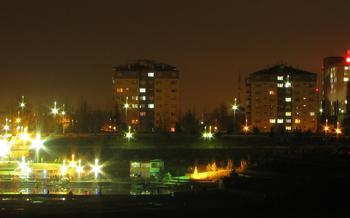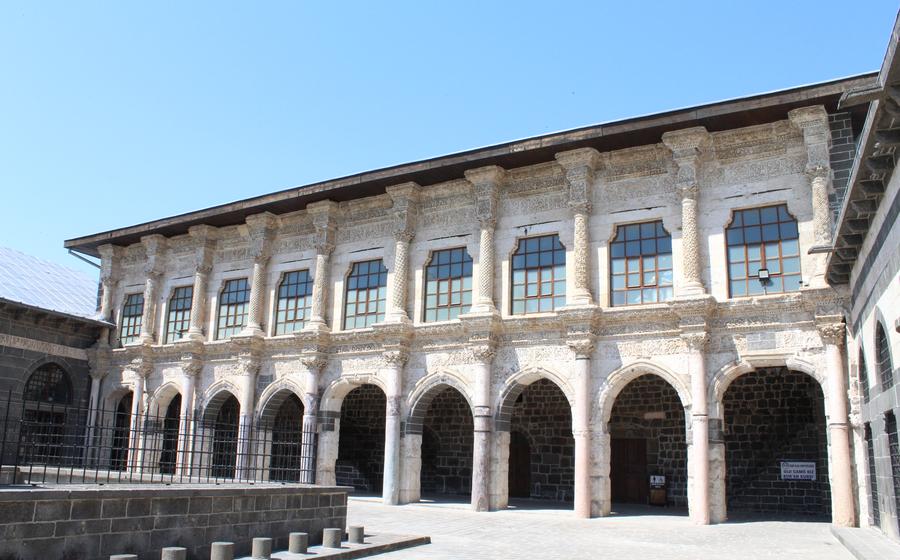
Diyarbakır Aslanhane (House of Lions)
- Diyarbakır Aslanhane (House of Lions): A Unique Historical Site
- Exploring the Legends and Myths Surrounding the Aslanhane
- Walking Through the Grand Entrance and Courtyard of the Aslanhane
- Admirin the Impressive Stone Lions at the Aslanhane
- Marveling at the Ancient Mosaics and Carvings
- Discovering the Hidden Chambers and Secret Passages
- Learning About the Aslanhane's Role in Different Historical Periods
- Unveiling the Architectural Wonders of the Aslanhane
- Experiencing the Cultural Events and Exhibitions
- Discovering the Local Crafts and Handicrafts at the Aslanhane
- Savoring the Delights of Local Cuisine at the Aslanhane
- Strolling Through the Picturesque Streets Around the Aslanhane
- Taking an Enriching Guided Tour of the Aslanhane
- Capturing Memorable Photos and Videos at the Aslanhane
- Insider Tip: Planning Your Visit to the Aslanhane
Diyarbakır Aslanhane (House of Lions): A Unique Historical Site
In the heart of the ancient city of Diyarbakır, Turkey, stands a magnificent historical site that has captivated the imaginations of travelers and locals alike for centuries: the Diyarbakır Aslanhane, also known as the House of Lions. This remarkable building, with its rich history, architectural significance, and cultural importance, is a must-visit destination for anyone seeking to delve into the depths of Turkey's rich heritage.
The Aslanhane boasts a fascinating history, dating back to the 11th century when it was constructed as part of a complex of buildings that included a palace, a mosque, and a hospital during the reign of the Artuqid dynasty. Over the centuries, it has served various purposes, from a caravanserai providing shelter for travelers and merchants to a prison during the Ottoman era. In the present day, the Aslanhane stands as a magnificent symbol of Diyarbakır's enduring legacy, attracting visitors from around the world who come to marvel at its beauty and explore its storied past.
Exploring the Legends and Myths Surrounding the Aslanhane
The Diyarbakır Aslanhane is steeped in a rich tapestry of legends and myths that have been passed down through generations, adding to its mystique and allure. The name "Aslanhane" itself, meaning "House of Lions," is steeped in symbolism and mythology. According to one legend, the city of Diyarbakır was once terrorized by a ferocious lion that preyed on its inhabitants. A brave warrior named Aslan Bey defeated the lion and brought its head back to the city as a trophy. To commemorate his victory, he built the Aslanhane as a symbol of strength and courage.
Another tale revolves around the belief that the stone lions placed at the entrance of the Aslanhane were once living creatures. It is said that a powerful sorcerer cast a spell on them, transforming them into stone to guard the city against evil spirits. The legends of the Aslanhane are deeply intertwined with the cultural identity of Diyarbakır, reflecting the city's rich history and the imagination of its people.
Walking Through the Grand Entrance and Courtyard of the Aslanhane
As you step through the imposing entrance of the Diyarbakır Aslanhane, a sense of awe and wonder washes over you. The grand doorway, adorned with intricate carvings and inscriptions, hints at the rich history and cultural significance that await within.
The spacious courtyard, bathed in the warm glow of the sun, invites you to pause and take in its serene atmosphere. With its high walls and elegant arches, the courtyard exudes an air of grandeur and timelessness.
Once a bustling gathering place for locals and travelers alike, the courtyard still retains its social charm. Imagine the lively conversations, laughter, and the exchange of stories that filled this space in centuries past. Perhaps merchants haggled over prices, scholars engaged in philosophical debates, or weary travelers sought refuge from their journeys.
As you wander through the courtyard, notice the intricate details that adorn the walls and arches. Floral motifs, geometric patterns, and verses from sacred texts are skillfully carved into the stone, showcasing the artistry and craftsmanship of the builders.
The courtyard also holds a special place in local folklore. Legends speak of secret meetings and hidden treasures concealed within its walls, adding an air of mystery and intrigue to the Aslanhane's allure.
Whether you choose to simply soak in the tranquility or let your imagination run wild, the courtyard of the Diyarbakır Aslanhane offers a unique glimpse into the past, inviting you to connect with the vibrant history and cultural heritage of this remarkable city.
Admirin the Impressive Stone Lions at the Aslanhane
The Aslanhane is home to a series of impressive stone lions that have become iconic symbols of Diyarbakır. These majestic creatures stand guard at the entrance to the building, their fierce expressions and intricate carvings captivating the attention of visitors. The lions are a testament to the skill and artistry of the craftsmen who created them, and their presence adds a touch of grandeur to the Aslanhane's already impressive facade.
The lions are carved from a single block of stone, and their muscular bodies and flowing manes are rendered in exquisite detail. Their eyes seem to follow visitors as they walk through the entrance, creating a sense of awe and wonder. The lions are more than just decorative elements; they also hold symbolic significance in Turkish culture. The lion is often associated with strength, courage, and royalty, and its presence at the Aslanhane suggests that the building was once a place of great importance and power.
There are several theories about the origin and meaning of the lions at the Aslanhane. Some believe that they were brought to Diyarbakır from another city, while others suggest that they were carved on-site by local craftsmen. There is also speculation that the lions were originally part of a larger ensemble of sculptures that adorned the building's facade, but that most of these sculptures were lost or destroyed over time.
Regardless of their origin or meaning, the stone lions of the Aslanhane have become an integral part of the building's identity. They are a beloved symbol of Diyarbakır and a reminder of the city's rich history and cultural heritage. Visitors to the Aslanhane are sure to be beeindrucked by these magnificent creatures, which stand as silent witnesses to the passage of time and the enduring legacy of the Aslanhane.
Marveling at the Ancient Mosaics and Carvings
As you step inside the Aslanhane, your eyes will be drawn to the exquisite mosaics and intricate carvings that adorn the walls and floors. These artistic treasures are a testament to the skill and artistry of the craftsmen who created them centuries ago.
The mosaics depict a variety of scenes, from hunting expeditions to mythical creatures. The colors are still vibrant and the details are remarkably preserved, offering a glimpse into the rich visual culture of Diyarbakir's past.
The carvings are equally impressive, showcasing a range of subjects from human figures to geometric patterns. The stone lions that give the building its name are particularly noteworthy, with their majestic presence and intricate details.
These mosaics and carvings are not just decorative elements; they also hold historical and cultural significance. They provide valuable insights into the beliefs, traditions, and artistic styles of the people who lived in Diyarbakir during different periods.
One of the most fascinating mosaics is located in the main hall of the Aslanhane. It depicts a scene of a royal procession, with musicians, dancers, and elaborate costumes. This mosaic is believed to date back to the 6th century AD and is considered a masterpiece of Byzantine art.
Another highlight is the series of carvings on the exterior walls of the building. These carvings depict scenes from the life of the Prophet Muhammad, as well as various animals and mythical creatures. They are a testament to the Islamic influence on Diyarbakir's art and architecture.
The mosaics and carvings of the Aslanhane are not just beautiful works of art; they are also important historical documents that provide valuable insights into the past. They are a must-see for anyone interested in the history, culture, and art of Diyarbakir.
Discovering the Hidden Chambers and Secret Passages
Within the enigmatic walls of the Aslanhane, hidden chambers and secret passages lie in wait, beckoning visitors to uncover their mysterious secrets. These hidden spaces, concealed from the casual observer, evoke a sense of intrigue and adventure, inviting one to step back in time and explore the untold stories of this ancient site.
The existence of these hidden chambers and secret passages has been whispered through the ages, fueling the imagination and curiosity of countless individuals. Some believe that these hidden spaces were used as meeting places for secret societies or as escape routes during times of conflict. Others speculate that they served as storage chambers for valuable treasures or as hiding places for those seeking refuge from persecution.
Regardless of their original purpose, these hidden chambers and secret passages offer a glimpse into the rich and complex history of the Aslanhane. They invite visitors to engage their imagination and ponder the untold stories that these hidden spaces hold. Whether real or imagined, the existence of these hidden chambers and secret passages adds an aura of mystery and intrigue to the Aslanhane, making it a truly captivating destination for history buffs and adventure seekers alike.
Learning About the Aslanhane's Role in Different Historical Periods
The Aslanhane, with its imposing presence, has stood witness to the ebb and flow of history, serving various purposes and playing significant roles throughout different eras. Originally constructed as a palace during the Artuqid dynasty in the 12th century, it served as a residence for the ruling family and their entourage. As time passed, the Aslanhane underwent transformations, adapting to the changing needs of successive civilizations.
During the Ottoman era, the building was used as a caravanserai, providing shelter and resting facilities for weary travelers and merchants traversing the Silk Road. The spacious courtyard and sturdy walls offered a safe haven for caravans and their precious goods, contributing to the region's vibrant trade and commerce. The Aslanhane's strategic location along major trade routes made it a crucial hub for cultural exchange and interaction between East and West.
In the 20th century, the Aslanhane underwent a remarkable transformation when it was converted into a museum. This decision showcased the Turkish government's commitment to preserving and celebrating its rich cultural heritage. The museum's exhibits and displays shed light on the captivating history of the Aslanhane and its significance in the context of Diyarbakır's vibrant past.
Today, the Aslanhane stands as a testament to the city's enduring spirit, having survived wars, conquests, and the passage of time. Its resilience and adaptability have made it a symbol of Diyarbakır's ability to embrace change while preserving its cultural roots.
Unveiling the Architectural Wonders of the Aslanhane
The Diyarbakır Aslanhane stands as a testament to the architectural brilliance of its time. Its unique design and construction techniques showcase the ingenuity and skill of the ancient builders. The building's exterior is adorned with intricate carvings and decorative elements, reflecting the rich artistic traditions of the region. The interior features a harmonious blend of architectural styles, including Islamic, Byzantine, and Armenian influences. Visitors can marvel at the grand arches, vaulted ceilings, and spacious chambers, each showcasing unique architectural features. The Aslanhane's sturdy construction has withstood the test of time, making it one of the best-preserved historical buildings in Diyarbakır. Exploring the architectural wonders of the Aslanhane is like stepping back in time and witnessing the craftsmanship and creativity of a bygone era.
Experiencing the Cultural Events and Exhibitions
The Diyarbakır Aslanhane is not just a historical site; it is also a vibrant cultural hub that hosts a variety of events and exhibitions throughout the year. These events are a fantastic way to experience the rich culture and heritage of Diyarbakır while immersing yourself in the unique atmosphere of the Aslanhane.
From traditional music concerts and dance performances to art exhibitions and book fairs, the Aslanhane offers a diverse range of cultural experiences. These events not only showcase the talents of local artists and performers but also provide a platform for cultural exchange and dialogue.
One of the highlights of the Aslanhane's cultural calendar is the annual Diyarbakır Culture and Art Festival. This week-long festival brings together artists, musicians, and performers from all over the region to celebrate the city's rich cultural heritage. The festival features a variety of events, including concerts, dance performances, art exhibitions, and traditional crafts demonstrations.
Attending a cultural event or exhibition at the Aslanhane is a unique and enriching experience that allows visitors to connect with the local community and gain a deeper understanding of Diyarbakır's vibrant culture. Be sure to check the Aslanhane's website or social media pages for upcoming events and exhibitions.
Discovering the Local Crafts and Handicrafts at the Aslanhane
The Aslanhane, renowned for its historical and cultural significance, is also a vibrant hub for local crafts and handicrafts. Within its walls, visitors can discover a treasure trove of unique products and souvenirs handcrafted by skilled artisans and craftspeople. From intricate textiles and pottery to exquisite jewelry and woodwork, the Aslanhane showcases the rich artistic heritage of Diyarbakır.
One of the highlights of the Aslanhane's craft scene is the vibrant carpet weaving tradition. Visitors can witness artisans meticulously weaving intricate patterns and designs onto colorful carpets, using techniques passed down through generations. The vibrant colors and intricate motifs reflect the unique cultural identity of the region and make for stunning souvenirs.
In addition to carpets, the Aslanhane is renowned for its beautiful pottery. Skilled potters use local clay to create a variety of ceramic pieces, including vases, bowls, and decorative tiles. Each piece is meticulously hand-painted with intricate designs, showcasing the artistic flair of the local artisans.
Jewelry lovers will find a treasure trove of unique pieces at the Aslanhane. From delicate silver earrings to statement necklaces adorned with semi-precious stones, the jewelry on display is both stylish and meaningful. Many of the pieces incorporate traditional Anatolian motifs, making them a symbol of the region's rich history and heritage.
For those seeking unique home décor items, the Aslanhane offers a variety of handcrafted wooden products. Artisans use local woods to create intricate carvings, decorative boxes, and furniture pieces. The intricate designs and warm tones of the wood add a touch of rustic charm to any home.
By purchasing handicrafts at the Aslanhane, visitors not only take home a piece of Diyarbakır's cultural heritage but also support local artisans and craftsmen. The sale of these products helps preserve traditional skills and techniques, ensuring that the vibrant craft traditions of the region continue to thrive for generations to come.
Savoring the Delights of Local Cuisine at the Aslanhane
Indulge in a culinary journey at the Aslanhane, where the tantalizing aromas of traditional Diyarbakir cuisine fill the air. Savor the flavors of delicious kebabs, slow-cooked stews, and freshly baked bread from local ovens. Discover hidden culinary gems such as "mumbar dolması," a unique dish of stuffed intestines, or "kaburga dolması," succulent lamb chops stuffed with rice and herbs. Vegetarian delights include "kısır," a vibrant bulgur salad with vegetables, and "imam bayıldı," tender eggplants stuffed with onions, garlic, and tomatoes. As you savor these culinary treasures, immerse yourself in the rich culinary heritage of Diyarbakir and create lasting memories of your visit to the Aslanhane.
Strolling Through the Picturesque Streets Around the Aslanhane
As you step out of the Aslanhane, you'll find yourself immersed in the charming streets and neighborhoods that surround this historical site. The area around the Aslanhane is a treasure trove of unique architecture, shops, and landmarks, each with its own story to tell.
Take a leisurely stroll down the narrow cobblestone streets, admiring the traditional houses with their intricate carvings and colorful facades. Discover hidden courtyards, where locals gather for tea and conversation. Explore the bustling bazaars, where you can find everything from handcrafted souvenirs to fresh produce and spices.
Don't miss the nearby historical sites, such as the Great Mosque of Diyarbakır, a stunning example of Islamic architecture, or the Diyarbakır Castle, which offers panoramic views of the city and the surrounding countryside.
As you wander through these picturesque streets, you'll feel the rich history and culture of Diyarbakır come alive. The Aslanhane may be the star attraction, but the surrounding neighborhoods are equally captivating and offer a glimpse into the everyday life of this vibrant city.
Taking an Enriching Guided Tour of the Aslanhane
To fully immerse yourself in the rich history and cultural significance of the Diyarbakır Aslanhane, consider embarking on a guided tour. Knowledgeable and experienced guides will lead you through the ancient halls and hidden chambers, sharing fascinating stories and insights that bring the Aslanhane's past to life.
Guided tours are available in various languages, ensuring that visitors from all over the world can learn about this remarkable site. Whether you prefer a private tour tailored to your specific interests or a group tour offering a lively exchange of ideas, there is an option to suit every traveler.
During the tour, you'll gain a deeper understanding of the Aslanhane's architectural features, its role in different historical periods, and the legends and myths that surround it. You'll also have the opportunity to ask questions and engage in discussions with your guide, ensuring a truly enriching and memorable experience.
Remember to book your guided tour in advance, especially during peak tourist season, to avoid disappointment. The Aslanhane's guided tours offer a unique and immersive way to explore this ancient treasure and create lasting memories of your visit to Diyarbakır.
Capturing Memorable Photos and Videos at the Aslanhane
The Aslanhane, with its captivating architecture, intricate carvings, and sprawling courtyard, offers a treasure trove of photo opportunities for visitors. To capture the essence of this historical site, it's essential to explore different angles, lighting conditions, and compositions. The golden hues of sunrise or sunset cast a magical glow on the stone lions and courtyard, creating a breathtaking backdrop for your shots. Take advantage of the natural light to enhance the textures and details of the carvings, creating images that are both aesthetically pleasing and historically significant. While capturing these memories, remember to be respectful of the cultural and historical significance of the site, ensuring your photography doesn't disrupt the tranquility of the Aslanhane. Share your stunning captures on social media, using relevant hashtags, to inspire and connect with fellow travelers and history enthusiasts worldwide.
Insider Tip: Planning Your Visit to the Aslanhane
When planning your visit to the Aslanhane, consider the following tips to make the most of your experience:
-
Timing is Key: Aim to visit the Aslanhane during the spring or fall to enjoy pleasant weather, avoiding the summer heat and winter cold. Check the weather forecast before your visit to ensure a comfortable exploration.
-
Explore at Your Own Pace: While guided tours offer valuable insights, consider exploring the Aslanhane independently to immerse yourself in its atmosphere and discover hidden details at your own pace.
-
Capture Memorable Moments: Remember to bring your camera to capture the stunning architecture, intricate carvings, and picturesque surroundings of the Aslanhane. Respect the rules and regulations regarding photography and videography.
-
Enjoy Local Delights: Take a break to savor the delicious local cuisine at one of the nearby restaurants. Sample traditional dishes that reflect the rich culinary heritage of Diyarbakır.
-
Extend Your Experience: Explore the surrounding neighborhoods to discover hidden gems, charming streets, and historic landmarks. Visit local markets, shops, and cafes to immerse yourself in the vibrant local culture.

